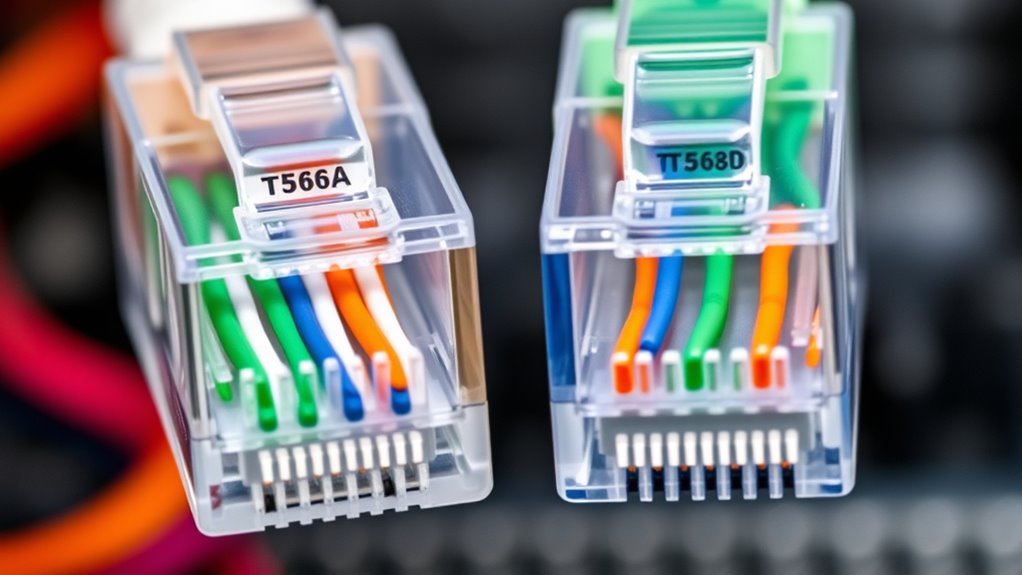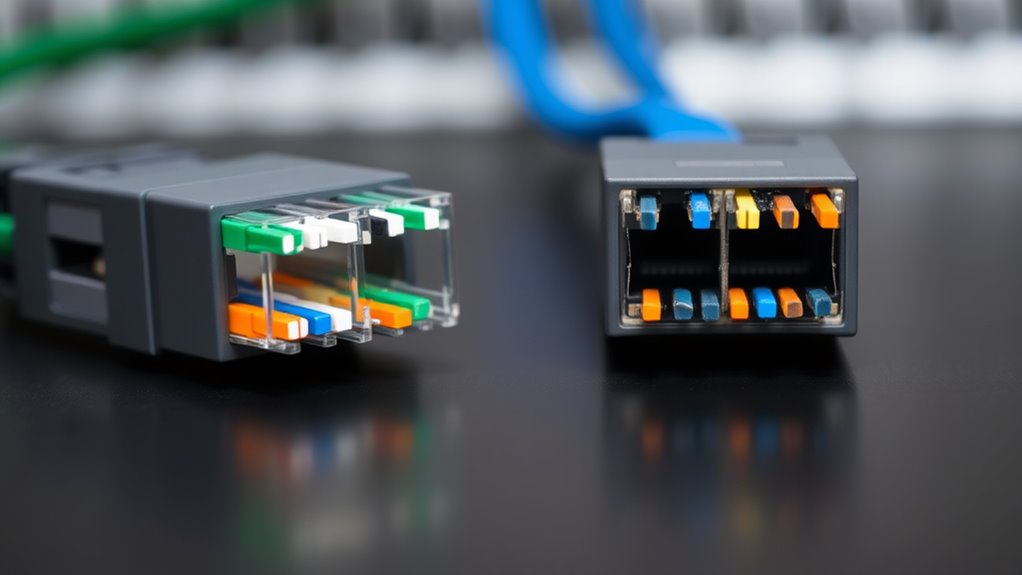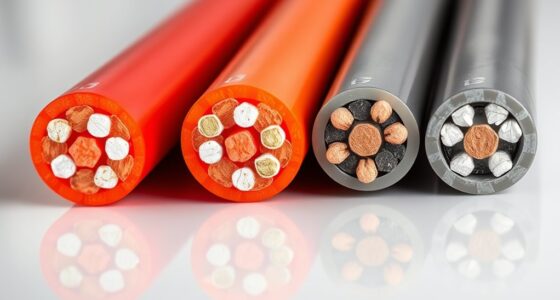Did you know that over 80% of Ethernet installations use the T568B wiring standard? Choosing the right termination style isn’t just a matter of preference—it influences your network’s performance and reliability. While T568A aligns with telephony standards and T568B is more common in commercial setups, mixing them can cause issues. Understanding the differences helps you avoid potential problems and guarantees your network runs smoothly. Want to know which style suits your needs best?
Key Takeaways
- T568A and T568B are wiring schemes with different pinout configurations for RJ45 connectors.
- T568A aligns with telephony standards; T568B is more common in commercial networks.
- Mixing the two schemes on the same cable or network can cause connectivity issues.
- Both support gigabit Ethernet speeds; performance is unaffected by the choice.
- Consistent use of one scheme ensures reliable network setup, troubleshooting, and future upgrades.

Have you ever wondered how different ways of ending a relationship or professional engagement can impact the people involved? When it comes to network cabling, this idea applies just as much. The termination style you choose, specifically between T568A and T568B wiring schemes, can influence not only the performance of your network but also how easily it integrates with existing systems. These standards are part of the cabling standards set by the Telecommunications Industry Association (TIA), guaranteeing consistent wiring practices. Understanding the differences between T568A and T568B is essential because they represent two wiring schemes used to terminate Ethernet cables, like twisted pair cables, which are common in LAN setups.
Both wiring schemes use the same color codes but differ in the order of the wire pairs. T568A and T568B each specify a different pinout configuration, which determines how the wires are connected to the RJ45 connector. If you’re setting up a new network or troubleshooting an existing one, knowing which termination style is in place helps prevent confusion and potential connectivity issues. For instance, mixing T568A and T568B on the same cable or within the same network segment can cause network problems, such as crosstalk or reduced performance. That’s why adhering to a consistent wiring scheme throughout your cabling infrastructure is vital.
Using consistent wiring schemes like T568A or T568B prevents network issues and ensures reliable connectivity.
In terms of cabling standards, both T568A and T568B are compliant, but they are often preferred by different organizations or regions. T568A is generally recommended for residential installations and is more aligned with older telephony wiring schemes, making it easier for compatibility with legacy systems. T568B, on the other hand, is more common in commercial environments and has become the de facto standard in many industries. When selecting a termination style, you should consider the existing wiring schemes in your environment to maintain uniformity and avoid mishaps.
Choosing between T568A and T568B doesn’t usually affect network performance directly, as both support gigabit speeds and higher. However, if you need to match the wiring scheme with existing cables or equipment, the decision becomes critical. Establishing a consistent wiring scheme helps streamline troubleshooting and future upgrades. Always remember that cabling standards and wiring schemes work together to guarantee reliable data transmission, and the way you terminate your cables directly influences network stability. Ultimately, your choice of termination style should align with your overall cabling plan, guaranteeing interoperability and ease of maintenance. Additionally, understanding the end-to-end wiring standards ensures compatibility across different devices and network segments.
Frequently Asked Questions
Can T568A and T568B Cables Be Mixed in the Same Network?
Yes, you can mix T568A and T568B cables in the same network, but it’s not recommended. Both wiring standards use different cable color codes, so consistency is key for proper connections. Mixing them can cause confusion, troubleshooting issues, or network problems. To guarantee peak performance, stick to one wiring standard throughout your network, and always double-check your cable color codes and wiring standards before terminating or connecting cables.
Which Termination Style Is More Future-Proof for Gigabit Ethernet?
You should choose T568B for future-proofing gigabit Ethernet, as it’s more widely adopted in the US and guarantees wiring consistency. Its cable durability and standardized wiring make it easier to maintain and upgrade over time. Using T568B helps prevent compatibility issues, supports higher data rates, and aligns with industry trends, making your network more reliable and ready for future technology advancements.
Are There Compatibility Issues With Different Network Devices Using T568A or T568B?
You won’t hit a snag with cable compatibility or device interoperability when using T568A or T568B. Both standards are designed to work seamlessly with modern network devices, and mixing them usually causes no issues, much like apples and oranges. Just confirm the same style is used on both ends of a cable for best results. Ultimately, the choice between T568A and T568B won’t slow down your network.
How Do I Identify Which Termination Style a Cable Uses?
You can identify which termination style a cable uses by examining the color coding and pin configuration at each end. Look at the wire pairs and their order; T568A and T568B have distinct color arrangements. If the order of the colors in the pin configuration matches the T568A pattern on both ends, it’s a T568A cable. Conversely, if it matches T568B, then that’s the style used.
Does the Choice of Termination Style Affect Network Performance?
Sure, your network performance isn’t magically better or worse just because you pick T568A or T568B. In reality, cable quality and installation practices matter far more. As long as you’re consistent and follow proper wiring procedures, both styles will perform equally well. So, don’t lose sleep over the style—focus on quality cables and careful termination. That’s the real secret to a reliable, speedy network.
Conclusion
Choosing between T568A and T568B is vital for reliable Ethernet connections. Notably, over 80% of commercial networks prefer T568B due to its widespread adoption. Whichever style you select, consistency is essential—mixing them can cause interference and connectivity issues. By sticking to one standard throughout your network, you guarantee ideal performance and easier troubleshooting. Keep this in mind to maintain a stable, high-quality network environment that meets your needs effectively.









